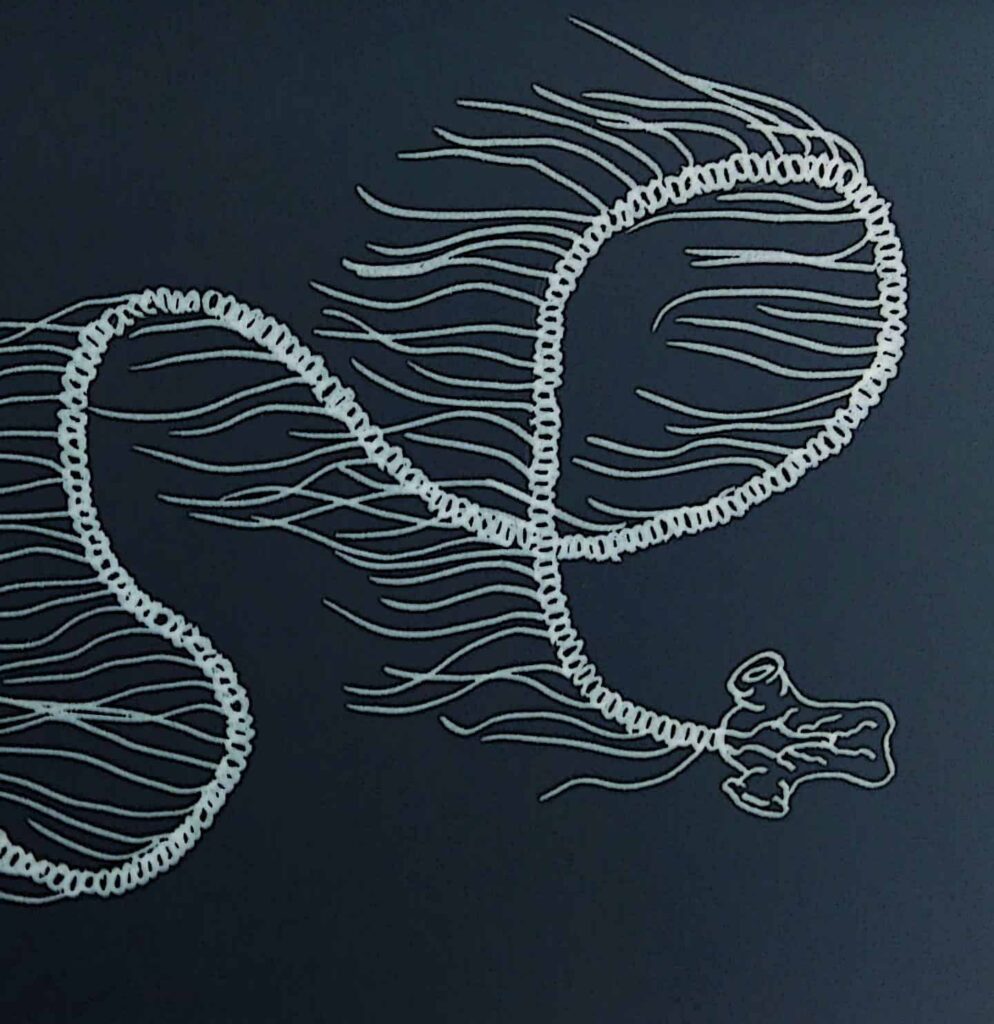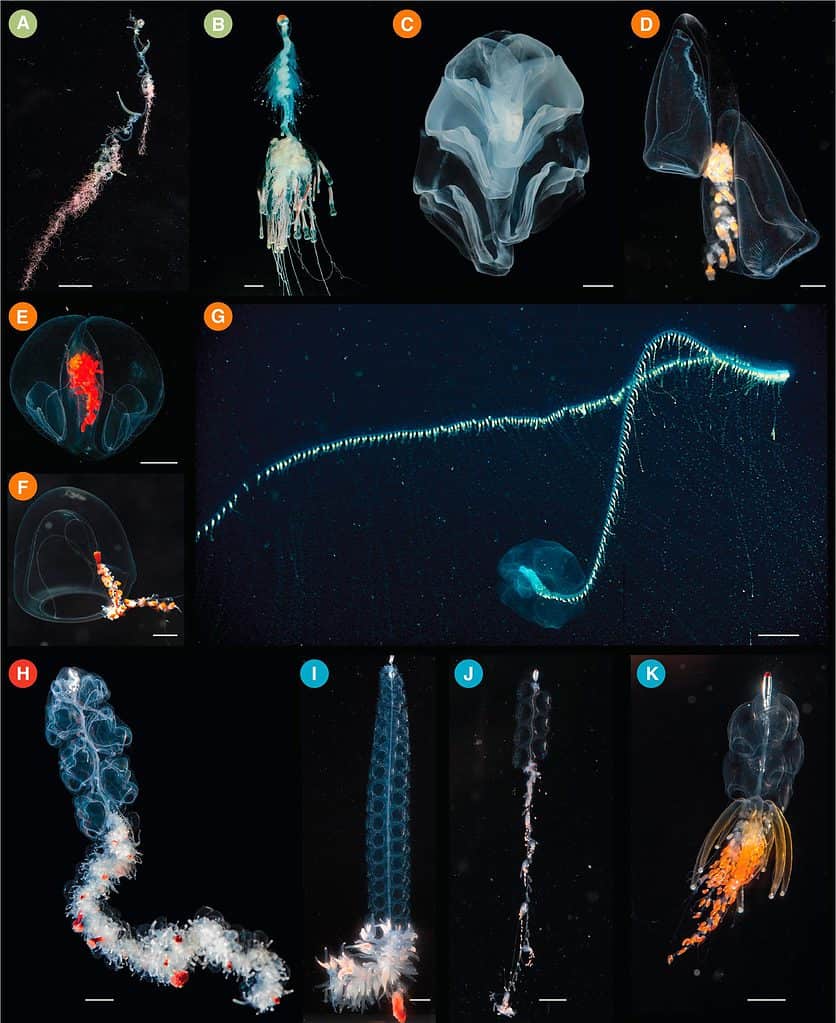Until recently, people generally agreed that the longest animal on earth was the blue whale, which can grow up to 110 feet long. But a strange, stinging aquatic predator — a cousin of the jellyfish — has recently upset the blue whale’s title. This animal — really more of a colony where each individual is basically a genetic clone — is the siphonophore. When the siphonophore’s colony grows great enough, it can form an organism over 150 feet long! That means that the longest animal in the world stretches half the length of a football field.
Discovery of the Siphonophore
A recent hunt at Australia’s Ningaloo Reef explored underwater canyons in the area. This is where scientists discovered the blue whale-beating siphonophore. The scientists on the expedition have measured 150 feet of the siphonophore — about 50% longer than a blue whale — but that’s only what they’ve been able to measure so far. One estimate says its full length could be nearly 400 feet.

Siphonophores exist as a colony comprised of smaller organisms that can’t survive without teaming up.
©Alzinous, CC BY-SA 4.0 – License
Behaviors of the Siphonophore
Siphonophores are a predatory species similar to jellyfish. They are string-like in shape, bioluminescent, and have a diaphanous, ghostly texture. They use their stingers to shock and eat plankton and krill. Yet they can also take down a fish or a small crustacean such as a crab, as well.
The best-known siphonophore cousin is the Portuguese man-o-war. Siphonophores are cnidarians, the same phylum as anemones and coral.
Though siphonophores are incredibly similar across the species in certain ways, some have unique and ingenious, hunting methods. The Erenna sirena is named for the sirens of Greek myth — beautiful mermaids whose alluring singing would attract sailors until their ships would crash upon concealed rocks. A sirena earns its name by displaying glowing bioluminescent tentacles, much as an anglerfish would, attracting prey with a dreamlike dance of death.
Make-up of the Siphonophore
Siphonophores have a fascinating physical makeup: they exist as a colony comprised of smaller organisms that can’t survive without teaming up. These organisms are known as zooids, and they are genetically identical to one another — effectively clones. This colony of identical zooids, each one only a millimeter in length, arrange themselves in long, string-like patterns. Though its composite parts are fragile on their own, they combine into a formidable predator. Siphonophores feed by trawling the water, filtering out plankton which their tentacles paralyze.
Even more amazingly, though the zooids are identical, they perform different roles within the larger organism of the siphonophore: the ones that sting, the ones that control motion, and the ones that digest its prey. The different types of zooids organize themselves in a repeating pattern along the length of the siphonophore — swimmer, eater, stinger, swimmer, eater, stinger, for example.
Let’s look at how this works in the Portuguese man-o-war, which is made up of four parts. Each part is called a polyp, and each polyp is comprised of zooids with a specialty job.
The first polyp is a balloon-like structure that allows the whole siphonophore to float. It’s called a pneumatophore. Then comes the tentacled polyp, which is venomous in order to paralyze plankton and small fish. The tentacles then pull their catch to the gastrozooids — the digestive polyp. The various zooids display a relationship known in the animal world as symbiosis: the collaborative behavior of different organisms living very near one another, to achieve a common goal neither can do on their own.

Siphonophores are closely related to jellyfish and several other zooid-composed colonial marine animals.
©2,192 × 2,685 pixels, file size: 634 KB, MIME type: image/jpeg – License
Evolution of the Siphonophore
The additional fascination of the way siphonophores behave is that, at one point in evolutionary history, organisms such as this were the most sophisticated yet. But we can see in zooid symbiosis a kind of building block for the more complicated organisms that would follow, where, instead of a team-up of simplistic organisms, an individual would be born with, for example, organs and nerve endings already baked-in.
But back to the siphonophore: all the zooids in the colony come from one egg. This egg grows into a polyp — basically, the animal equivalent of a flower bud — and from this protozooid, an entire colony’s worth of zooids grows.
Animals Similar to Siphonophore
Siphonophores aren’t the only colony organisms found in the seas and oceans.
Pyrosomes — in the literal Greek, “fire body” — is a translucent, sock-shaped colonial marine animal. Like the siphonophore, it’s made up of thousands of zooids. But pyrosomes have a much brighter quality which glows blue and green. Also unlike the “trawler” shape of the siphonophore, the pyrosome traps its prey within its tube-like body.
Bryozoa is also a filter-feeding colony like siphonophore. However, Bryozoa sports a different shape and habits. In freshwater, Bryozoa’s zooids grow into a jelly-like blob. In salt water, they will attach to a surface and form a crust on it — an external skeleton made up of calcium carbonate. Once formed, they grow branch-like structures in which to catch prey. Unlike many such species, Bryozoa’s hard skeletons can turn into fossils. (In fact, there are more fossils of Bryozoa than of any other animal!) For this reason, we know that Bryozoa have been with us for at least 500 million years.
Yet no other colony animal comes close to siphonophore’s length. At half a football field, it’s the longest animal on earth!
The photo featured at the top of this post is © Peter Leahy/Shutterstock.com
Thank you for reading! Have some feedback for us? Contact the AZ Animals editorial team.







